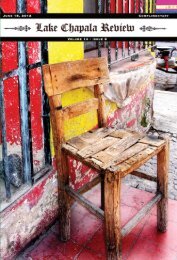Volume 10 - Issue 1, February 15, 2008 - Lake Chapala Review
Volume 10 - Issue 1, February 15, 2008 - Lake Chapala Review
Volume 10 - Issue 1, February 15, 2008 - Lake Chapala Review
Create successful ePaper yourself
Turn your PDF publications into a flip-book with our unique Google optimized e-Paper software.
Page 56 <strong>Lake</strong> <strong>Chapala</strong> <strong>Review</strong><br />
<strong>February</strong> <strong>2008</strong><br />
Energy Experts Live What They Preach<br />
by Louise Drummond Making a difference<br />
Barbara Bannon Harwood, known to friends as Pia, is<br />
the beautiful scion of a brilliant family. Her father was<br />
a professor of Chemistry and Physics in Nebraska. Her<br />
grandfather was a County Commissioner; her father a<br />
City Councilman and mayor. I can imagine her growing<br />
up in that down to earth, big sky country, out in nature<br />
enough to form questions about its substance and its<br />
cycles, and having a father who could explain the natural<br />
phenomena she encountered. At the same time, she got<br />
to witness her grandfather and father live out their own<br />
can-do attitudes. She also had an allergy to many things,<br />
including formaldehyde. All these facts would figure large<br />
in her future.<br />
Having had curiosity encouraged, she became a<br />
journalist and honed her ability to ask questions while<br />
working for the Chicago Sun Times. It was during her<br />
time there that she and her children took food one winter<br />
day to a poor urban family. They found a hungry elderly<br />
couple living in a cold, drafty apartment, freezing wind<br />
whistling through its leaky windows. Harwood and her<br />
family brought back plastic to cover windows, a small<br />
heater, and used carpet to warm the floors. She left there<br />
with a spiritual epiphany, wondering how she could help<br />
to create better housing for the poor.<br />
The universe always answers our questions, and<br />
shortly, as part of a work assignment, she was sent to<br />
do a story on a small passive-solar house in southern<br />
Illinois. The occupants had the same income as those of<br />
the family she had helped earlier in Chicago, but these<br />
people had enough to eat, and their home was warm and<br />
comfortable, tucked into a south-facing hill and fronted<br />
with glass to capture the sun’s heat. The southern Illinois<br />
couple needed only $30 per winter to heat their house,<br />
burning half a cord of wood in an iron stove. The Chicago<br />
couple was spending $500 every month, their entire<br />
Social Security check, to pay rent and fossil-fuel based<br />
power heating.<br />
The advantages of passive-solar design were instantly<br />
apparent, and she began to lobby to use passive-solar<br />
concepts and energy efficient construction in designs<br />
for low-income housing, demonstrating their cost<br />
effectiveness. At that time, in 1980, there was very<br />
little literature on the subject of low-income housing<br />
and energy-efficiency or passive solar heating. Through<br />
her research and active lobbying efforts, she literally<br />
changed perceptions of what could be done with low-cost<br />
housing. She began with Owens-Corning, manufacturer<br />
of fiberglass insulation products, pointing out to them<br />
that they could sell more insulation if they advertised<br />
how much fuel the increased levels of insulation would<br />
save. They took the bait, creating the EPDS, or Energy<br />
Performance Design System, now called the Pink Panther<br />
Program. She gave her first public speech on low-income<br />
housing and energy issues in 1989 on the podium at a<br />
housing conference with the venerable Senator Alan<br />
Cranston. At that time the government was spending five<br />
billion dollars a year to cool and heat public housing. She<br />
said that was a ridiculous waste of money, and suggested<br />
they start improving the energy efficiency of the buildings<br />
to reduce the bills.<br />
Having researched the fields of passive-solar<br />
architecture and energy efficient building materials, in<br />
1984, Harwood started her own low-income housing<br />
construction company, BBH Enterprises, in Dallas, Texas<br />
where she put in a small subdivision. Until the sale of that<br />
company, and the subsequently created Enviro Custom




